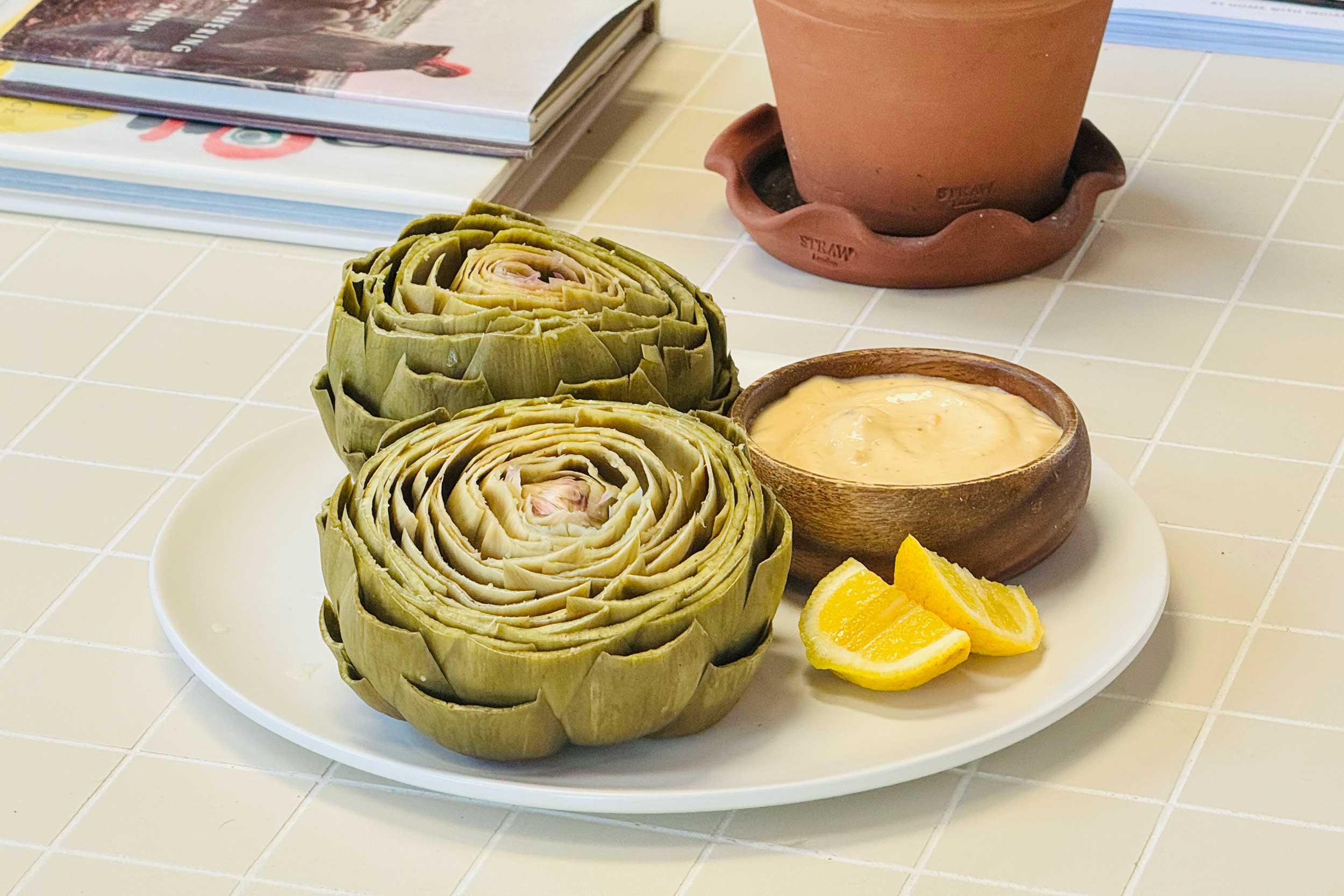Hey crew, and welcome back to Cool Beans! I started our journey into spring with the sweet and simple splendor that is the green pea, but today’s subject has a more prickly reputation. I’m talking about artichokes, an often-intimidating vegetable with a rather confusing anatomy. Allow me to simplify:
Artichokes are edible flowers; botanically speaking, they’re part of the thistle family. Eating a fresh one is a journey and a delicious lesson in patience. First you must remove their tough outer green leaves, which are fibrous and inedible. Inside, you’ll find the prickly, and aptly named, “choke.” Scoop out this cluster of fibers with a spoon, and you’re left with the crown jewel of the artichoke, the meaty, tender heart. If you’ve ever cooked with jarred artichokes, the heart is what you’re using.
Many artichoke recipes favor the heart, but the leaves are a delicious part of this adventure. Each one has a bit of tender flesh at the base which you can scrape with your teeth as you eat your way to the heart. Plus, those leaves have a perfectly bowl-like curve that makes them excellent vehicles for dips. We love ‘em for snacks or quick midday meals on a plant-based diet, because they’re high in fiber, which helps keep you feeling full, and a large one has more than 5 grams of protein, which is a decent amount for a veggie.
Today I’m showing you the absolute easiest way to prepare a whole artichoke, but first I’m sharing my favorite new way to eat the jarred hearts (for when you can’t be bothered at all).
The review: A lobsterless lobster roll
The quickest and easiest way to consume artichokes is to buy jarred hearts. They come either brined or marinated in oil and can be used in salads or added to dips, like our spinach-artichoke dip and butter bean hummus. You can roast them for a crispy grain bowl topper or shred them up and pile them on a sandwich, which is precisely what prolific veggie cookbook author does in her fun, ’choke-based take on a lobster roll.
To mimic the taste of the warm-weather classic, McKinnon combines the tender hearts with mayo and Old Bay–inspired spices like celery seed, paprika, chili powder, and garlic powder. She folds in plenty of chopped dill, celery, and chives and piles the mixture onto some buttered buns. For a final hit of oceanic flavor, she sprinkles the mix with furikake, a seasoning blend made of seaweed, toasted sesame seeds, salt, and sugar. (It’s the same trick I used in this edamame “tuna” salad.)
Straight out of the jar, artichoke hearts are hardly a dead ringer for the sweet crustacean, but when prepared and seasoned this way they’re a clever mimic for the lobster roll experience. The artichokes themselves are tender yet firm enough to give a meaty bite to the sando along with a slight tang, which complements the richness of the mayo. If you’ve got a jar of hearts lingering in the pantry, this recipe helps you turn them into a meal in less than 10 minutes. If you’ve got a bit more time and are ready to go full steam ahead with whole artichoke cookery, keep reading.
The guide: The easiest way to cook artichokes
There’s a bunch of ways to cook artichokes, from roasting and braising to frying and grilling. One of my first lessons in culinary school was learning how to prep a whole artichoke for steaming. Steamed artichokes make a great appetizer or elevated afternoon snack. For a heartier plate, you’re going to want to stuff ’em.
More than 10 years later, I still find steaming to be the easiest (and least wasteful) way to prepare the armored veggie. It requires less prep than just cooking the hearts, and you can even do it in the microwave if you don’t have a steamer. Artichokes start to oxidize the second you slice them, so keep a lemon around for rubbing down any exposed bits to prevent browning. To eat, peel off the leaves and dip them in a sauce, like our garlic-miso mayo. Once you make it to the center, scrape out the fuzzy choke and eat the tender heart.
When shopping for artichokes, look for bright, healthy leaves and a center that’s firm when squeezed. Keep artichokes unwashed in the fridge in a perforated bag, where they’ll last for a week or more. Wash just before you cook them.

Steamed Artichoke with Garlic-Miso Mayo
Yield: 2 to 4 servings
Ingredients:
2 artichokes
½ lemon
5 garlic cloves, skin on
2 teaspoons olive oil
¾ cup mayonnaise
2 tablespoons white miso paste
1 tablespoon lemon juice
¼ teaspoon salt
¼ teaspoon black pepper
Procedure:
Preheat the oven to 350 degrees.
Prep the ‘chokes. If your artichokes have stems, use a serrated knife to cut off the stem right at the base.* Then cut off the top third of the artichoke. Using kitchen shears, snip off the top portion of each leaf to remove the thorny part. Rub the cut side of the artichoke all over with the lemon half to prevent browning.
Cook the artichokes.
On the stovetop: Place a steamer basket in a large pot with a couple inches of water and bring to a simmer. Set the artichokes in the basket, stem side up, cover and cook for 30 minutes or until you can pull a leaf from the base without any effort.
In the microwave: Place artichokes in a bowl large enough to hold the veggies and ¾ cup water. Cover the bowl with a microwave-safe lid or wrap and cook for about 5 minutes or until the outer leaves easily release and the flesh attached is tender. If necessary, keep microwaving in 1-minute increments until done.
Make the dipping sauce. Meanwhile, place the whole garlic cloves on a baking sheet and toss with olive oil. Roast for 25 to 30 minutes, or until softened. Cool slightly, then remove the skin and place the garlic in a food processor along with mayonnaise, miso paste, lemon juice, salt, and pepper. Blend until smooth. Serve with artichokes.
Notes and Substitutions:
Artichoke stems are edible (and as delicious as the hearts!), but they might block you from being able to close the steamer pot, which is why we snip them off in this preparation. Once you remove the stems, cut away the fibrous outer layers surrounding the white-ish core of the stem. You can then toss them right into the steamer to cook with the whole ‘chokes—or slice them thin to eat raw in a salad.

